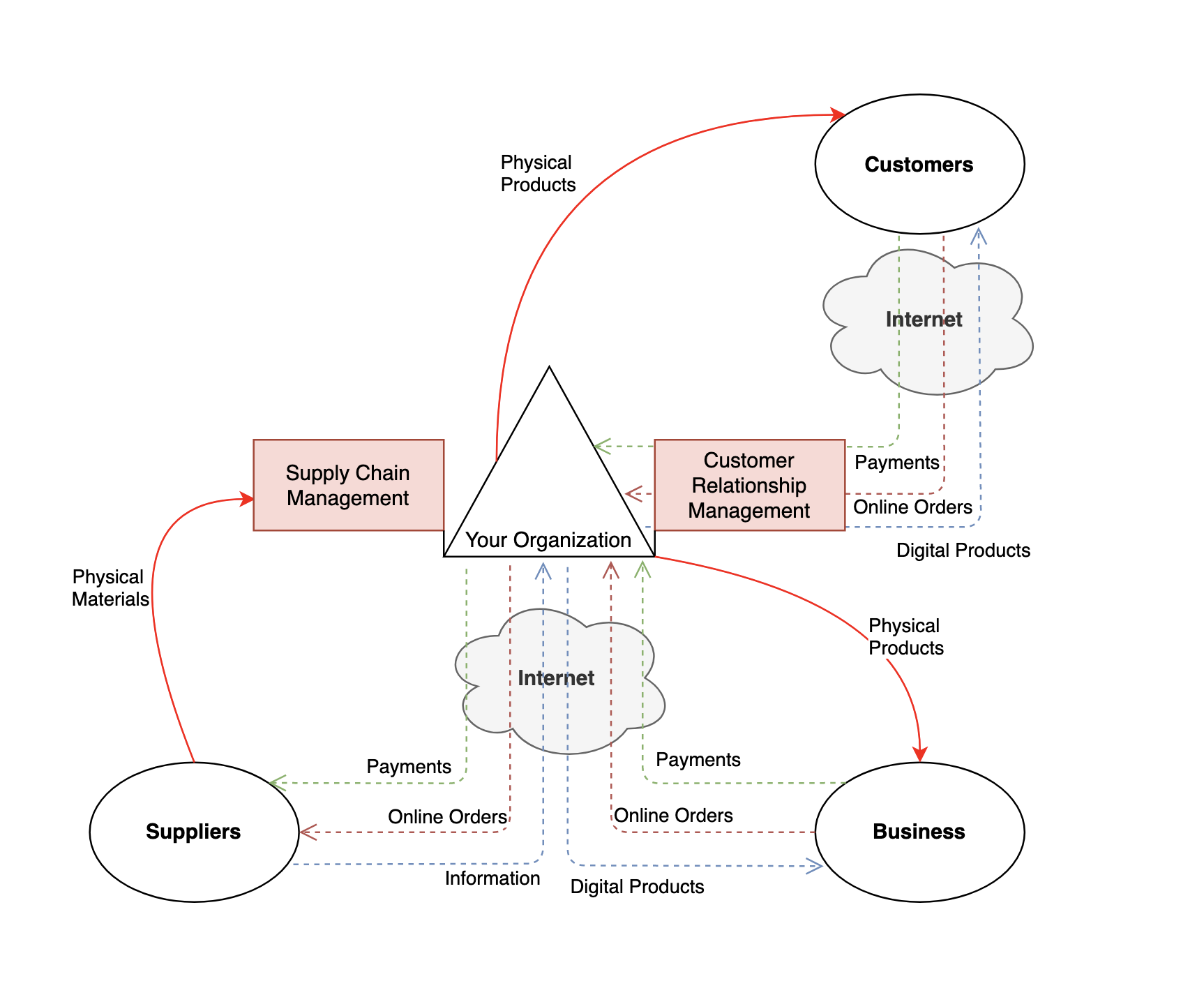Enterprise Information – Star Snowflake ERP EAI
Star and Snowflake Schemas
In relational implementation, the dimensional designs are mapped to a relational set of tables. You can implement the design into following two methods:
- Star Schema
- Snowflake Schema
What Is a Star Schema?
A star schema model can be depicted as a simple star: a central table contains fact data and multiple tables radiate out from it, connected by the primary and foreign keys of the database. In a star schema implementation, Warehouse Builder stores the dimension data in a single table or view for all the dimension levels.
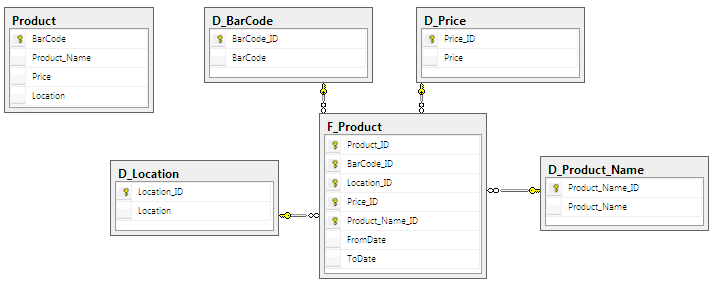
Star Schema (Prod_to_dwh.gif)
Author: BennyPJ
This image is licensed under the Creative Commons Attribution-Share Alike 3.0 Unported license.
Star and Snowflake Schemas Cont.
In relational implementation, the dimensional designs are mapped to a relational set of tables. You can implement the design into following two methods:
- Star Schema
- Snowflake Schema
What Is a Snowflake Schema?
The snowflake schema represents a dimensional model which is also composed of a central fact table and a set of constituent dimension tables which are further normalized into sub-dimension tables. In a snowflake schema implementation, Warehouse Builder uses more than one table or view to store the dimension data. Separate database tables or views store data pertaining to each level in the dimension.
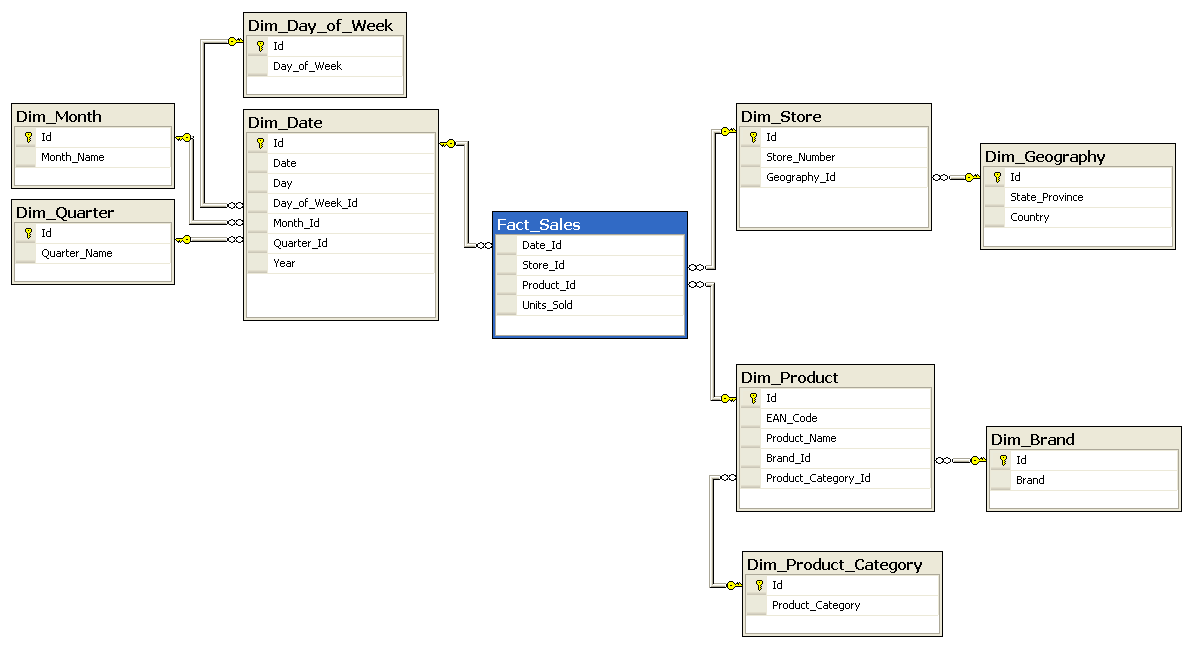
Snowflake Schema (Snowflake-schema-example.png)
Author: SqlPac
This image is licensed under the Creative Commons Attribution-Share Alike 3.0 Unported license.
Attribution: SqlPac at English Wikipedia
When do you use Snowflake Schema Implementation?
Ralph Kimball, the data warehousing guru, proposes three cases where snowflake implementation is not only acceptable but is also the key to a successful design:
- Large customer dimensions where, for example, 80 percent of the fact table measurements involve anonymous visitors about whom you collect little detail, and 20 percent involve reliably registered customers about whom you collect much detailed data by tracking many dimensions.
- Financial product dimensions for banks, brokerage houses, and insurance companies, because each of the individual products has a host of special attributes not shared by other products.
- Multienterprise calendar dimensions because each organization has idiosyncratic fiscal periods, seasons, and holidays.
Ralph Kimball recommends that in most of the other cases, star schemas are a better solution. Although redundancy is reduced in a normalized snowflake, more joins are required. Kimball usually advises that it is not a good idea to expose end users to a physical snowflake design, because it almost always compromises understandability and performance.
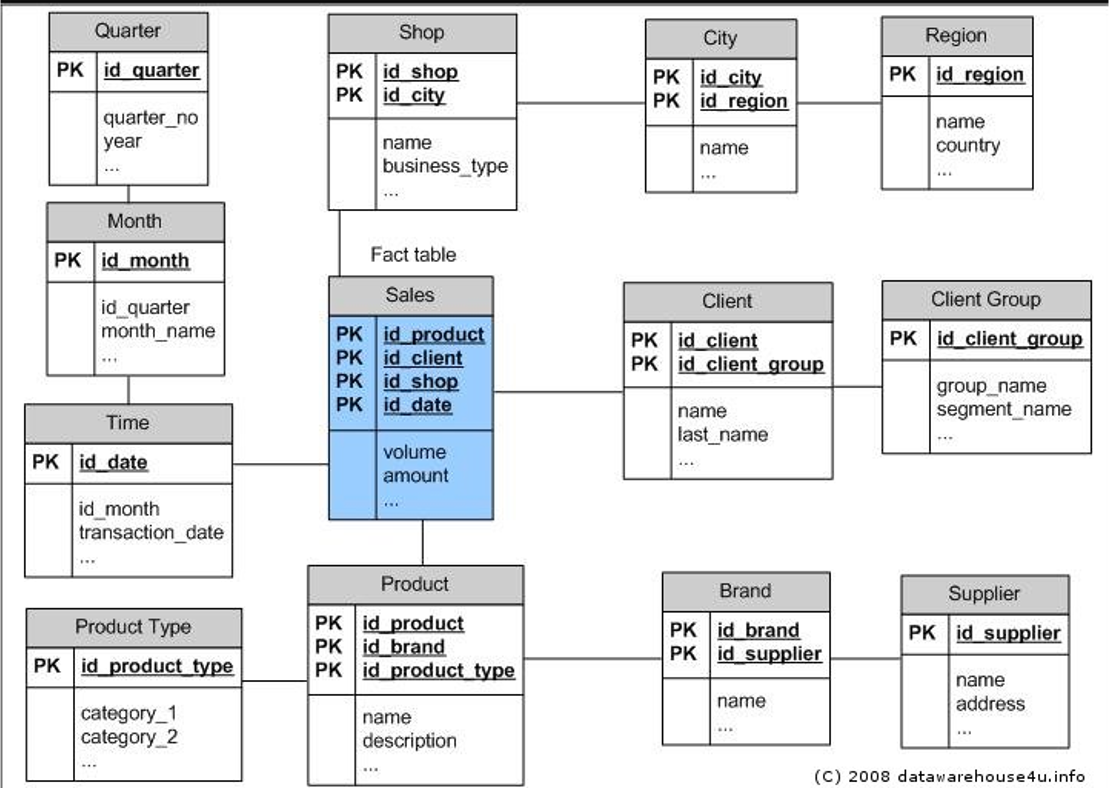

Samples and Sample Databases at:
https://CodePlex.com/SqlServerSamples
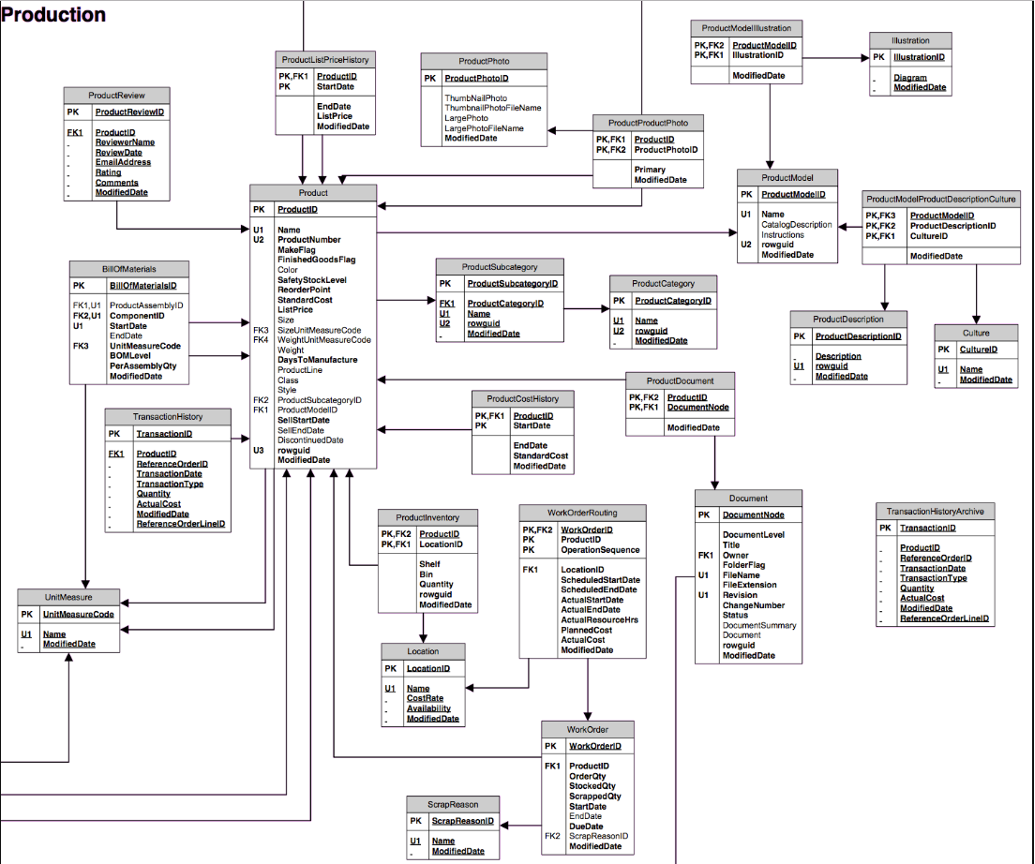
Char Vs. Varchar
The CHAR and VARCHAR Types
The CHAR and VARCHAR types are similar, but differ in the way they are stored and retrieved. They also differ in maximum length and in whether trailing spaces are retained.
The CHAR and VARCHAR types are declared with a length that indicates the maximum number of characters you want to store. For example, CHAR(30) can hold up to 30 characters.
The length of a CHAR column is fixed to the length that you declare when you create the table. The length can be any value from 0 to 255. When CHAR values are stored, they are right-padded with spaces to the specified length. When CHAR values are retrieved, trailing spaces are removed unless the PAD_CHAR_TO_FULL_LENGTH SQL mode is enabled.
Values in VARCHAR columns are variable-length strings. The length can be specified as a value from 0 to 65,535. The effective maximum length of a VARCHAR is subject to the maximum row size (65,535 bytes, which is shared among all columns) and the character set used. See Section C.10.4, “Limits on Table Column Count and Row Size”.
In contrast to CHAR, VARCHAR values are stored as a 1-byte or 2-byte length prefix plus data. The length prefix indicates the number of bytes in the value. A column uses one length byte if values require no more than 255 bytes, two length bytes if values may require more than 255 bytes.
If strict SQL mode is not enabled and you assign a value to a CHAR or VARCHAR column that exceeds the column’s maximum length, the value is truncated to fit and a warning is generated. For truncation of nonspace characters, you can cause an error to occur (rather than a warning) and suppress insertion of the value by using strict SQL mode. See Section 5.1.8, “Server SQL Modes”.
For VARCHAR columns, trailing spaces in excess of the column length are truncated prior to insertion and a warning is generated, regardless of the SQL mode in use. ForCHAR columns, truncation of excess trailing spaces from inserted values is performed silently regardless of the SQL mode.
VARCHAR values are not padded when they are stored. Trailing spaces are retained when values are stored and retrieved, in conformance with standard SQL.
The following table illustrates the differences between CHAR and VARCHAR by showing the result of storing various string values into CHAR(4) and VARCHAR(4) columns (assuming that the column uses a single-byte character set such as latin1).
Information Systems Vary by Scope
Personal Information System
- Use by single individual
- Simple Procedures
- Easy to learn
- Documentation light
- Timing controlled by subscriber
- Little or No Workflow
Workgroup Information System (Departmental)
- Facilitate group activities
- Shared Access
- Common Procedures (Across group)
- Requires group training, documentation
- Versions – all change together
- Issues resolved within group
- Results may impact other parts of an organization
Enterprise Information System
- Span an entire organization
- Multi User access
- Large numbers of users (000’s)
- Formal Procedures
- Audit trails
- Group Rights and Permissions for Access (role based)
- Documentation light
- Change usually a large project – Change Management
- May be subject to Manufacturers versioning, can impact related systems (e.g. office)
- Workflow commonly available
Inter Enterprise Information System
- Shared by multiple Organizations
- May be Industry or channel based
- Can have 000,000’s users
- Common procedures
- Issues/changes require inter-organizational cooperation
- Versions – all change together
- Usually UG’s form, boards representing multiple orgs.
- Results may impact other parts of an organization
Enterprise Information Systems – CRM, ERP, EAI
Contact Management vs CRM
- Contact Management keeps contact info
- May be Personal or workgroup
- Focus on managing contact data, appointments
- May have proprietary Data structures
- CRM has process imbedded
- Track Metrics
- May update from other corporate systems ( Order History, Payments, etc.)
- State Machine – Funnel
- In general, a state machine is any device that stores the status of something at a given time and can operate on input to change the status and/or cause an action.
- Formal Database – SQL
- Inherent processes for managing all customer interactions (Customer Service?)
| Department | Application |
|---|---|
| Sales and Marketing |
|
Enterprise Application Integration (EAI)
- Suite of software to integrate existing applications together
- Connects system “islands” via new software layer
- Enables existing applications to communicate and share data
- Leverages existing systems, leaving functional applications as is, but providding integration top layer
- Enables a gradual move to ERP
EAI Automatically Makes Data Conversions Among Different Systems
Virtual Integrated Database
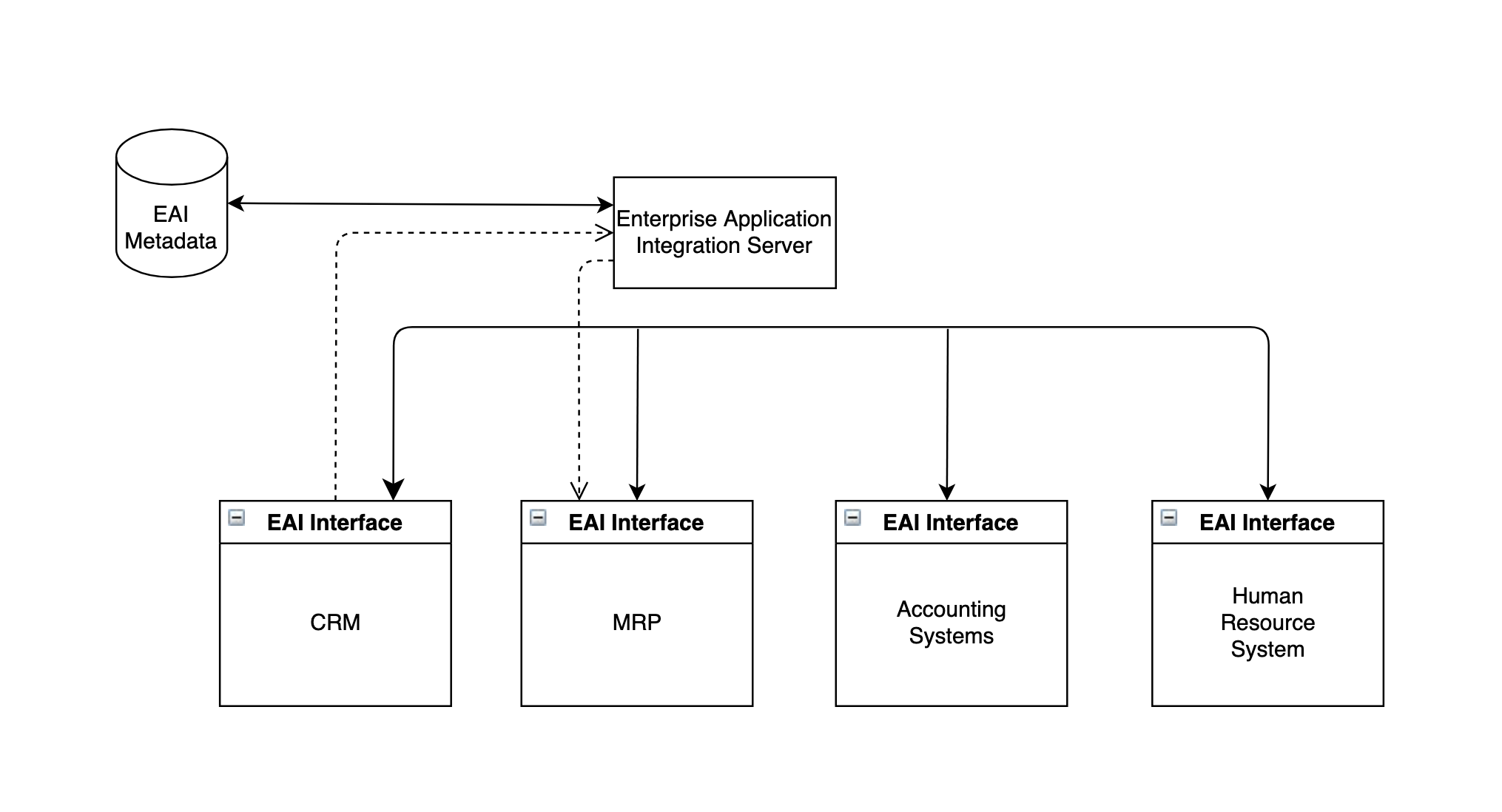
ERP – Enterprise Resource Planning
- Database
- Suite of Applications
- Set of processes for consolidating operations
- Modules for functions with common data structure – Avoid Silos
- Expensive lengthy implementations almost always involve process transformation.
- Industry Templates
- Configurable to a degree
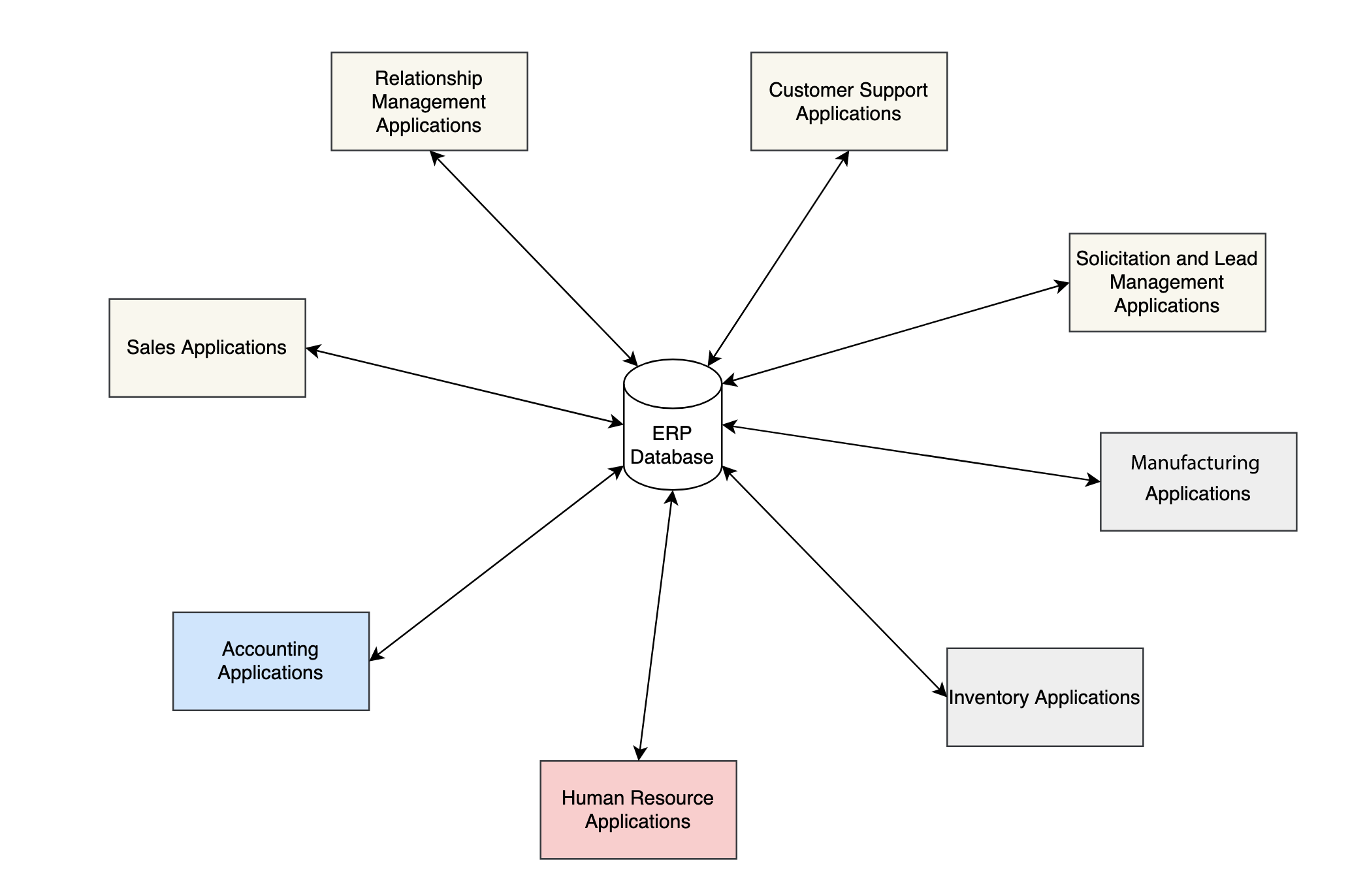
Enterprise Resource Planning

Title: Accounting Software Singapore ERP
Author: accounting software
Source: Flickr
License: Attribution-NonCommercial-ShareAlike 2.0 Generic (CC BY-NC-SA 2.0)
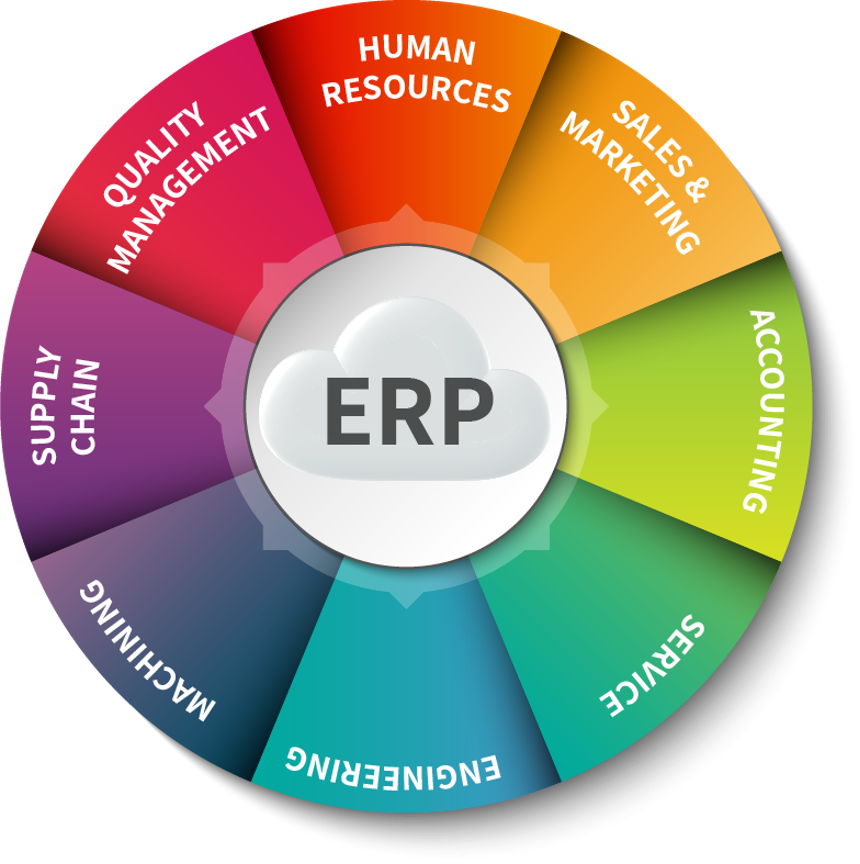
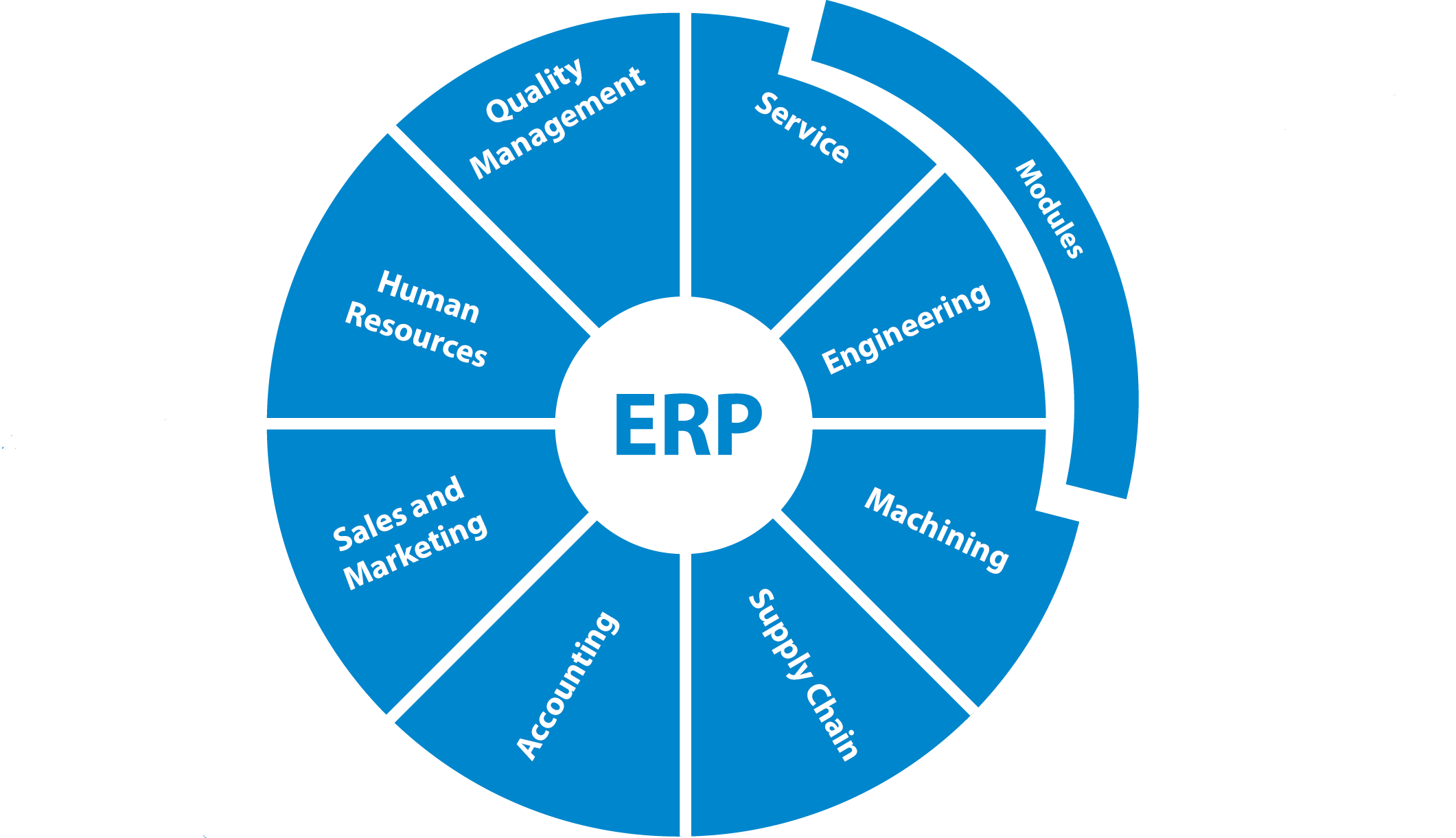
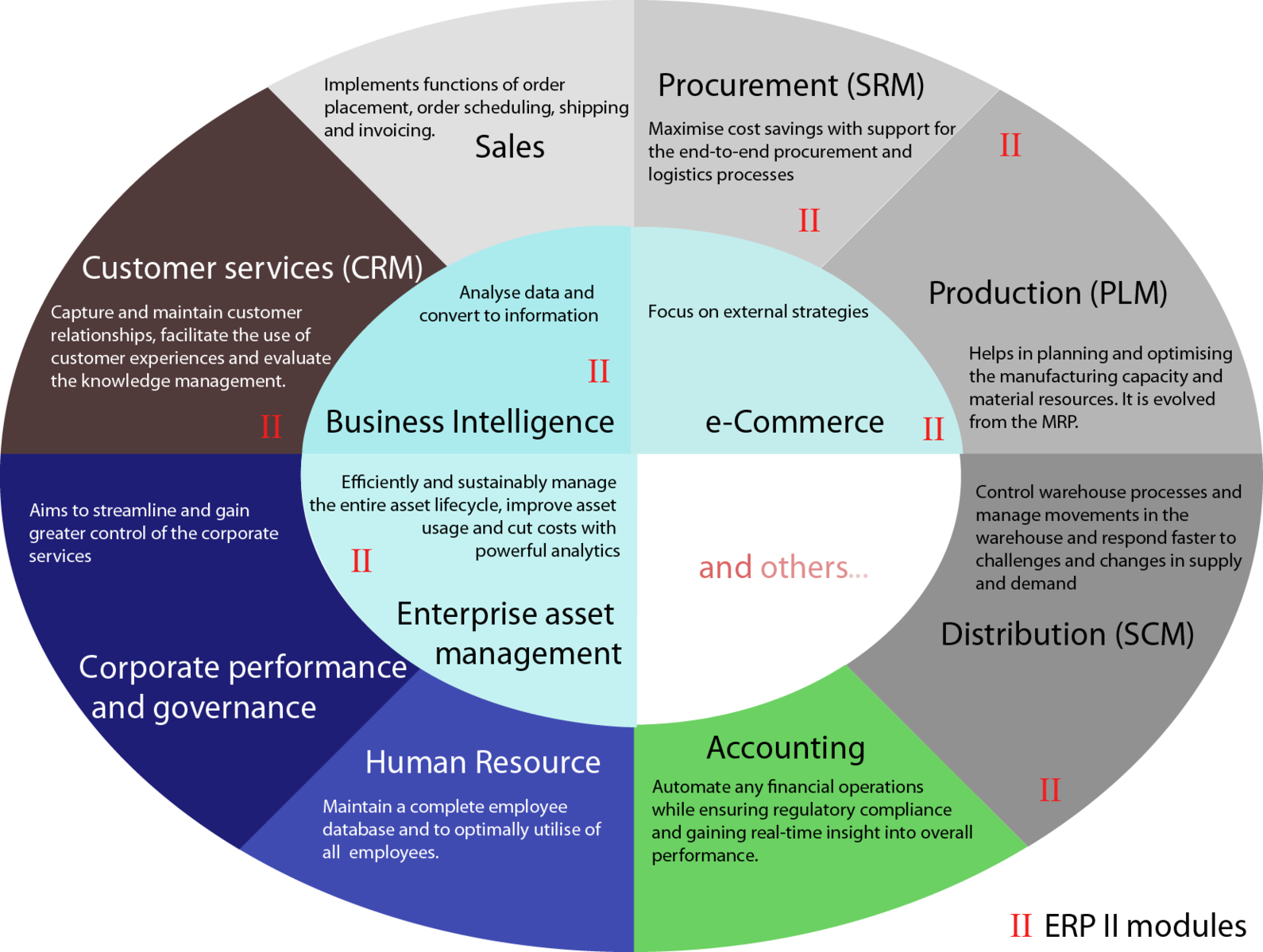
Title: ERP II Modules
Author: Shing Hin Yeung
License: Creative Commons Attribution-Share Alike 3.0 Unported
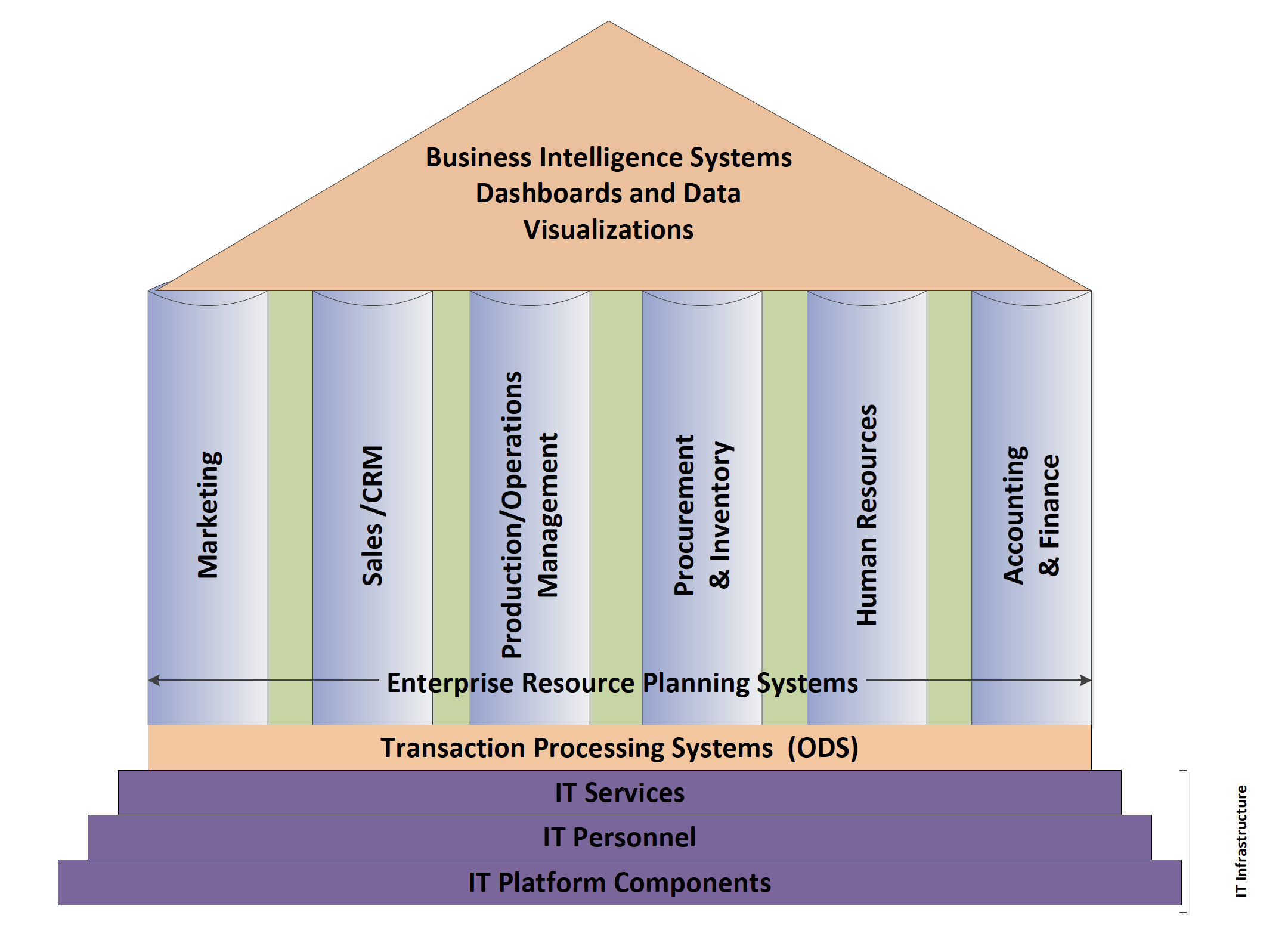
IS that Function Among Multiple Organizations
